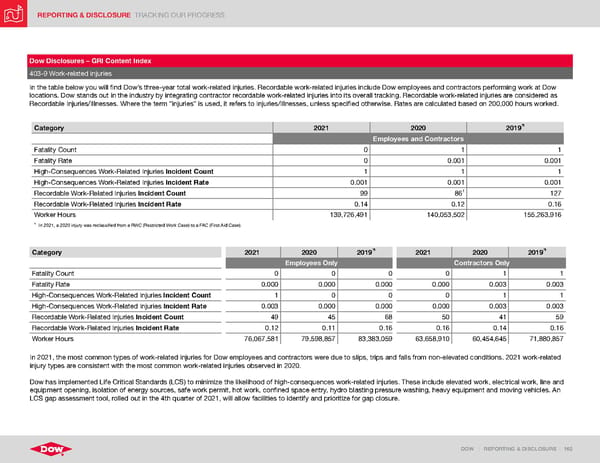REPORTING & DISCLOSURE TRACKING OUR PROGRESS DOW | REPORTING & DISCLOSURE | 162 Dow Disclosures – GRI Content Index 403-9 Work-related injuries In the table below you will find Dow’s three-year total work-related injuries. Recordable work-related injuries include Dow employees and contractors performing work at Dow locations. Dow stands out in the industry by integrating contractor recordable work-related injuries into its overall tracking. Recordable work-related injuries are considered as Recordable Injuries/Illnesses. Where the term “injuries” is used, it refers to Injuries/Illnesses, unless specified otherwise. Rates are calculated based on 200,000 hours worked. Category 2021 2020 2019 Employees and Contractors Fatality Count 0 1 1 Fatality Rate 0 0.001 0.001 High-Consequences Work-Related Injuries Incident Count 1 1 1 High-Consequences Work-Related Injuries Incident Rate 0.001 0.001 0.001 Recordable Work-Related Injuries Incident Count 99 86 1 127 Recordable Work-Related Injuries Incident Rate 0.14 0.12 0.16 Worker Hours 139,726,491 140,053,502 155,263,916 1 In 2021, a 2020 injury was reclassified from a RWC (Restricted Work Case) to a FAC (First Aid Case). Category 2021 2020 2019 2021 2020 2019 Employees Only Contractors Only Fatality Count 0 0 0 0 1 1 Fatality Rate 0.000 0.000 0.000 0.000 0.003 0.003 High-Consequences Work-Related Injuries Incident Count 1 0 0 0 1 1 High-Consequences Work-Related Injuries Incident Rate 0.003 0.000 0.000 0.000 0.003 0.003 Recordable Work-Related Injuries Incident Count 49 45 68 50 41 59 Recordable Work-Related Injuries Incident Rate 0.12 0.11 0.16 0.16 0.14 0.16 Worker Hours 76,067,581 79,598,857 83,383,059 63,658,910 60,454,645 71,880,857 In 2021, the most common types of work-related injuries for Dow employees and contractors were due to slips, trips and falls from non-elevated conditions. 2021 work-related injury types are consistent with the most common work-related injuries observed in 2020. Dow has implemented Life Critical Standards (LCS) to minimize the likelihood of high-consequences work-related injuries. These include elevated work, electrical work, line and equipment opening, isolation of energy sources, safe work permit, hot work, confined space entry, hydro blasting pressure washing, heavy equipment and moving vehicles. An LCS gap assessment tool, rolled out in the 4th quarter of 2021, will allow facilities to identify and prioritize for gap closure.
 ESG Report | Dow Page 161 Page 163
ESG Report | Dow Page 161 Page 163